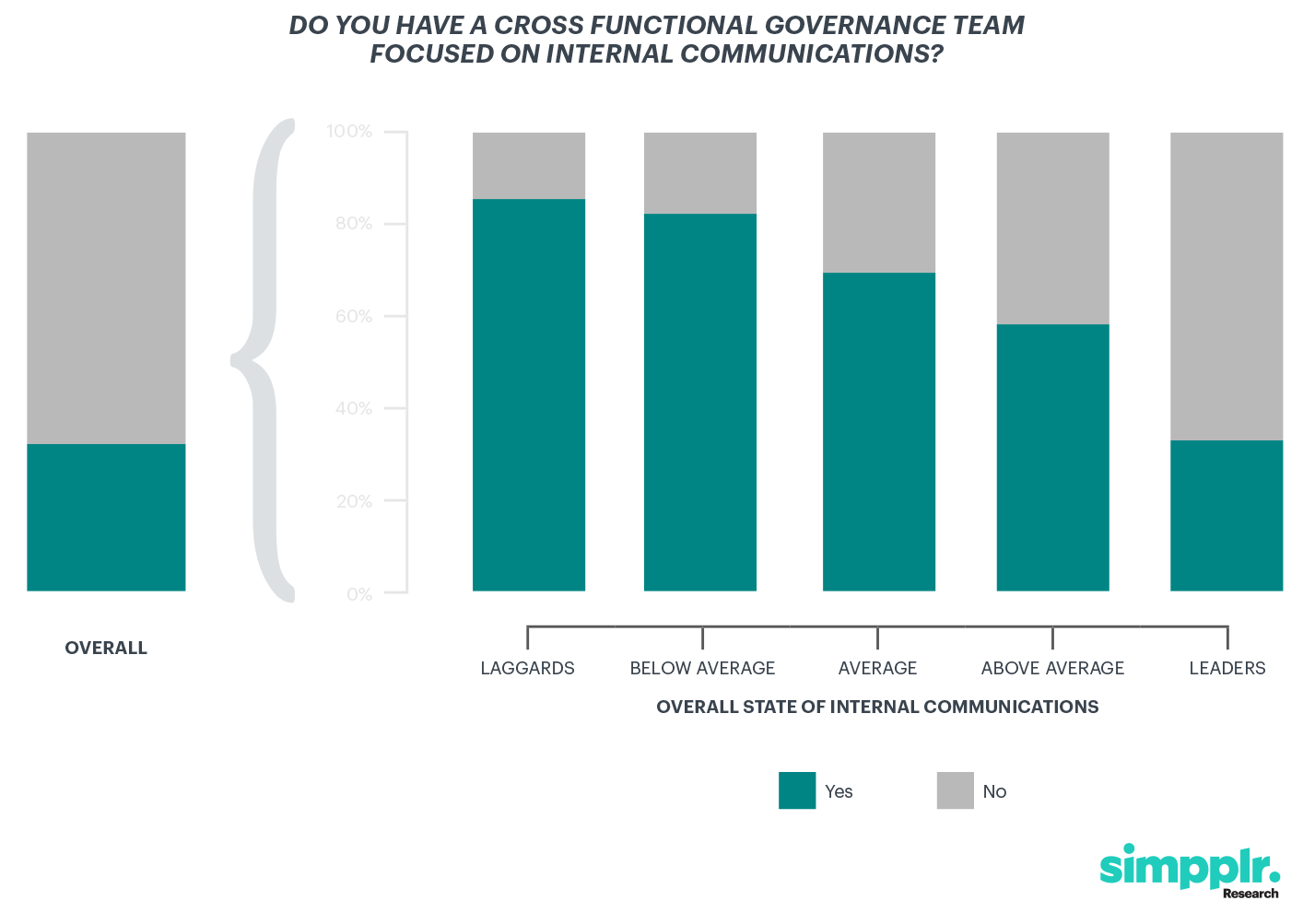Unclear ownership and lack of governance was cited as the top reason for intranet failure based on Simpplr Research’s State of Internal Communications 2019. We dug deeper to understand the impact of governance on not only intranets, but how it extends to internal communications as a function. Learn what data governance teams have to do with internal communications and intranet success.

Data Analysis: This chart shows the relationship between establishing a cross-functional governance team for your organization and internal communications quality. The percentage of organizations responding that they do have a cross-functional governance team is broken out in the 5 bars on the right, by the quality of internal communications (Laggards, Below Average, Average, Above Average, Leaders). The leftmost bar summarizes the overall (aggregated) responses to the question. In general, only about 30% of organizations have established a cross-functional governance team. However, this proportion is increasing in the overall state of internal communications. Amongst laggards in internal communications, only about 20% of organizations have established cross-functional governance teams. Conversely, leaders in internal communications are over 3 times more likely to have established cross-function governance teams. Note that the inverse relationship also shows an increasing trend. The overall state of internal communications is higher in organizations that have cross-functional governance committees than in organizations that do not. Note briefly that this difference (which is about a 1.5 point difference on a 1-5 scale) can be derived from the chart above using Bayes’ Rule: P(A|B) = [P(B|A)*P(A)]/P(B).
What is governance?
Governance by definition, refers to a set of policies or process that allow decision-making. In the context of intranets, governance requires a group of individuals who operate on an agreed-upon structure that enables an intranet to operate smoothly and functionally on an ongoing basis. To understand governance more, read our The Ultimate Intranet Governance Checklist. To learn and distinguish between content governance and process governance, read Intranet Governance: Content and Policies.
The role of data governance teams
Because the purpose of internal communications is to align the workforce, it’s important that there are diverse stakeholders that represent each function of the company. Typically, a cross-functional data governance team involves:
- Internal Communications (typically the project owner)
- IT
- Marketing
- Human Resources
- Executive representation
A data governance team improves overall internal communications
Out of the 400+ companies we surveyed, only 35% of the organizations have an established governance committee. This is discerning because governance is critical to internal communications success. In fact, one top reason intranets fail is due to a lack of governance. When looking at the data segmented by leaders vs. laggards, leaders are 175% more likely to have a governance committee. The data Simpplr Research analyzed suggests that having a cross-functional data governance team increases the overall state of internal communications program. The increasing trend suggests that having an established governance committee will help internal communications be more successful in achieving goals.
Internal communications and the intranet
Remember, the purpose of internal communications is to align the company – starting from leadership. Organizational alignment means employees understand the purpose of their work and how it contributes to the company’s strategic goals. Based on our research, Simpplr found that the intranet is one of the best tools to align an organization. To learn more, read: Chart of the Week: Why a great intranet matters more than you think.
What governance has to do with internal communications
A cross-functional governance team is important to the function of internal communications to align and unify an organization. Typically, the internal communications department owns a major part of the intranet because it serves as a vehicle for internal communications. Based on research, we know that governance is critical for intranet success. So if internal communications teams use the intranet to achieve their purpose, and we know the correlation between of an established governance and the success of intranets, we can confidently agree that governance has a large impact on internal communications.
The intranet is an effective vehicle for internal communications to connect, align, and engage the workforce so that employees and leadership march together and work to achieve shared goals. Modern intranets are purposefully designed for this purpose, unlike emails or chat tools that can get inundated with noise and clutter.
Data governance teams and internal communications success
Generally speaking, internal communications is part of the governance team. The internal communications function typically manages the governance team and sets rules, processes, and expectations. Establishing a data governance team is important because it enforces accountability for each person to work toward the agreed-upon goal. In most cases, the goal is finding out the most effective way to promote communications throughout the company, aligning and connecting the entire organization.
Without a governance committee, goals are subject to differ and there is a loss of accountability. Governance team cooperation is critical for success of internal communications because internal communications involves curating and delivering messages and campaigns on behalf of management, as well as engaging all employees across the organization. Thus, governance committee meetings should be held regularly to discuss priorities, alignment, and progress.
For best practices and more information on how to form your governance committee, read our blog: Forming your governance committee 101.














